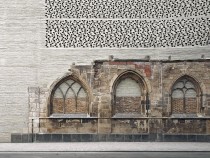
© Jochen Helle/artur
While the architectural scene has been dominated in recent years by new materials, innovative surfaces and organic forms, for many architects, bricks seemed to offer less scope for expression because of their standardized dimensions and limited range of surface finishes. Is it not possible, though, to make stones sing, as Goethe imagined when standing before the temple in Paestum? Bricks were the first artificially made building material in the history of man. As early as 2600 BC, an entire city was built in Mohenjo-Daro in the Indus Valley, using bricks of a size that could be held in the human hand. In the first half of the 19th century, architects like Karl Friedrich Schinkel were the first to see the unclad brick facades of early factory buildings in Britain as a fitting expression of progress and industrialization. With the Building Academy (ill. 5), the Friedrichswerder Church, and the Altes Museum in Berlin, Schinkel established brick architecture as an essential part of our building culture.








